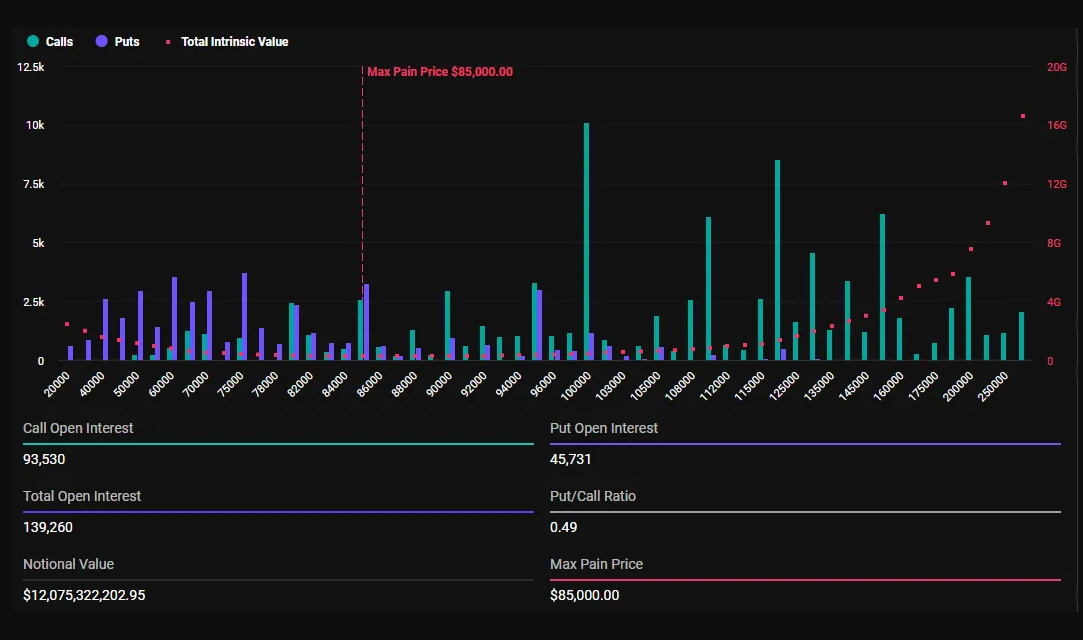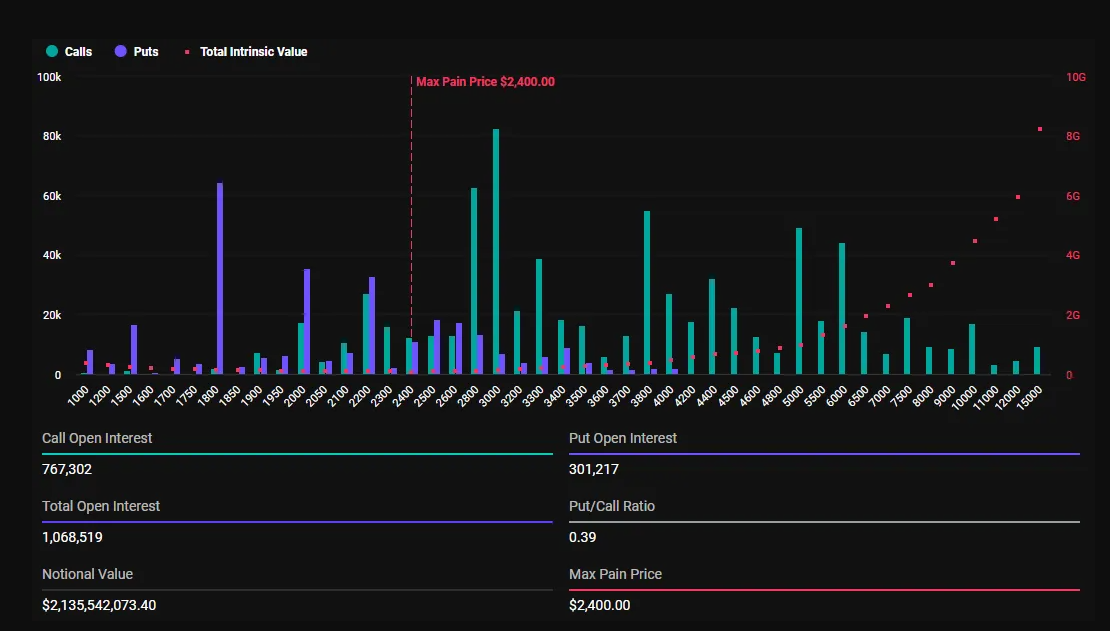Bitcoin (BTC) and Ethereum (ETH) options valued about $14.21 billion are set to expire today.
Because it can affect short-term trends through the volume of contracts and their notional value, market observers are paying close attention to this event.
$14.21 billion Bitcoin and Ethereum options expiring
The Bitcoin options that expire today have a notional value of $12.075 billion. Deribit’s data indicates that the put-to-call ratio for these 139,260 Bitcoin options that are about to expire is 0.49. This ratio indicates that buy options (calls) are more common than sell options (puts).
Additionally, the research shows that $85,000 is the maximum pain point for these expiring options. The price at which the asset will result in the largest financial losses for holders is known as the maximum pain point.

Today marks the expiration of 1,068,519 Ethereum options contracts in addition to Bitcoin options. The put-to-call ratio is 0.39, the highest pain point is $2,400, and the notional value of these expiring options is $2.135 billion.
Compared to last week, there are a lot more Bitcoin and Ethereum options expiring today. According to data, there were 21,596 and 133,447 contracts for BTC and ETH options that expired last week, respectively. Similarly, their respective notional values were $264.46 million and $1.826 billion.

Due to the fact that this Friday is the last Friday of March, the options that expire this week are for both the month and the quarter. Because it is consistent with conventional financial (TradFi) market processes and gives traders a regular schedule, Deribit options expire on Fridays.
Options contract expiry dates are typically fixed at the conclusion of the trading week, usually Friday, in many international markets, such as derivatives and stocks, in order to standardize timing and streamline settlement procedures.
Deribit implemented this practice to keep traders accustomed to switching from TradFi to cryptocurrency marketplaces and to guarantee that market activity and liquidity peak at a consistent time.
🚨 Q1 Options Expiry Alert 🚨
Tomorrow is not just any Friday, it’s one of the biggest expiries of the year.
Over $14.3B in BTC and ETH options are set to expire at 08:00 UTC.$BTC: Notional: $12.17B | Put/Call: 0.48 | Max Pain: $85K$ETH: Notional: $2.15B | Put/Call: 0.39 |… pic.twitter.com/7hE2CO15E9— Deribit (@DeribitOfficial) March 27, 2025
Implied volatility heading into quarterly options expiry
In fact, the first quarter (Q1) of options expirations comes to an end with today’s expiration. The implied volatility (IV) curves for Bitcoin and Ethereum, which indicate market expectations of price fluctuations, are monitored by experts at Deribit, a cryptocurrency derivatives exchange, as this occurs.
In particular, because calls are priced significantly higher than puts, Bitcoin’s curve shows a strong tilt toward higher prices (upside skew). Ethereum’s volatility curve, on the other hand, is flatter, indicating less directional bias but still showing high volatility. This suggests expected price volatility near the $14.21 options’ expiration date.
Implied vol heading into expiry 👇
Chart 1 – $BTC: BTC showing some serious upside skew, calls priced way higher.
Chart 2 – $ETH: ETH’s curve is flatter, but vol’s still elevated across the board.
Both markets signal anticipation of movement into or post-expiry.
Track it all… pic.twitter.com/bXhepKMNhN
— Deribit (@DeribitOfficial) March 27, 2025
This implies that the markets for Ethereum and Bitcoin both expect movement before or after expiration. In other articles, Greeks.live experts discussed the state of the market and pointed out that investors’ perception of Bitcoin is dominated by a cautiously pessimistic stance.
In particular, they imply that the majority of traders expect a retest of lower price levels between $84,000 and $85,000. As of this writing, Bitcoin is trading around $85,960, which suggests a possible short-term decline.
But according to other traders, Bitcoin is trapped in a narrow, range-bound trading pattern, which suggests that there won’t be much volatility until a breakout happens. Greeks.live identifies important technical levels against this backdrop.
“Key resistance levels being watched are 88,400 where significant passive selling was observed, and potential support at 77,000 which one trader called the definite bottom,” the analysts wrote.
The quarterly delivery is also putting pressure on implied volatility, according to Greeks.live analysts, who also see notable variations in the IV Mark. This implies that traders may be able to take advantage of these swings by using automated or manual tactics.
Binance founder CZ refutes exchange listing impact on crypto prices
Changpeng Zhao (CZ), the founder of Binance, repeated a lot of market chatter and denied that CEX listings have an effect on the price of cryptocurrencies.
Changpeng Zhao, the founder of Binance, recently made news throughout the world by disputing the idea that a cryptocurrency’s price is impacted by CEX listing. Investors are perplexed by the founder’s latest remarks, which run counter to past statistics showing cryptocurrency listings drive price increases. Echoing a massive market buzz, CZ said, “In fact, listing a coin shouldn’t affect its price in the first place.”
Binance founder CZ negates exchange listing’s impact on crypto’s price
In a Friday, March 28 response to an X user named Jason, CZ stated that a coin’s listing shouldn’t have an impact on its value. Although the listings provide liquidity, there may be a short-term effect and little chance of long-term advantages.
The creator of Binance also believes that one of the most important elements influencing long-term price movements is the project’s progress. Rather, he emphasizes DEX’s operational framework.
CZ deems DEXs better?
Changpeng ended by saying, “The DEX model is great—all coins are listed, and people choose for themselves,” which sparked waves of speculation. Notably, DEXs give traders access to a wide variety of tokens, but market risks are still considerable.
CZ spotlights BNB listing
The founder of Binance simultaneously emphasized the launch of BNB perpetual futures on Coinbase, another leading cryptocurrency exchange, in another X post the same day. “No one applied for this,” the entrepreneur explained in reference to this listing. Concentrate on construction. Listing is a natural process.
Along with his earlier comments on the effect of a CEX listing on cryptocurrency prices, this statement has caused market participants all around the world to take notice.
Recent listings for MUBARAK coin fuels additional speculations
Concurrently, amid major listings, MUBARAK coin, a cryptocurrency that is strongly thought to be connected to CZ, has recently received a lot of popularity. According to CoinGape, Binance listed MUBARAK today and included it in its list of offers. However, the token’s price plummeted to $0.09558, a roughly 40% decrease, in spite of the listing. This story also supported earlier assertions that CEX listings had no effect on cryptocurrency pricing.
However, CoinGape previously discovered that the price of MUBARAK increased by more than 20% when the CEX introduced a perpetual contract for the cryptocurrency. In addition, another token, CZ’s Dog (BROCCOLI), increased by about 10% after its launch on the same market, igniting rumors to the contrary in response to previous remarks.
Coinbase Institutional open-sources MPC library to promote industry-wide security
Coinbase Institutional has released its multi-party computation cryptography library to the public in an effort to increase security in the cryptocurrency space.
By enabling several parties to sign transactions without sharing their private keys, MPC technology reduces the possibility of theft or unauthorized access. On March 27, Coinbase revealed that they have technical documentation to assist developers with incorporating MPC into their systems, as well as open-sourced tools for transaction signing and secure key security.
We’re open-sourcing our multiparty computation (MPC) cryptography library, setting a new industry benchmark for cryptographic transparency.
While this technology already helps safeguard Coinbase assets, we’re raising the bar for security across the industry by making it…
— Coinbase Institutional 🛡️ (@CoinbaseInsto) March 27, 2025
Developers and organizations may now effortlessly include MPC into their security systems thanks to the code being made accessible on GitHub. By making these tools open-source, Coinbase intends to encourage the industry’s broader use of cutting-edge security measures. Additionally, the corporation has started a bug bounty program to help security experts find mistakes in the code.
The company’s institutional platform, Coinbase Prime, has expanded quickly since its launch in 2021, collecting $404 billion in assets and enabling $364 billion in quarterly institutional trading activity. At the moment, it supports 250 assets for trading and over 430 assets for custody. Improving security continues to be its top priority as more institutions adopt Coinbase Prime for safe transactions and custody.
Coinbase Institutional’s most recent action comes as cyberattacks targeting the cryptocurrency sector are rapidly increasing. According to Immunefi’s Q1 2025 report, hackers stole $1.64 billion in the first quarter alone, marking it the worst quarter for security breaches ever.
Centralized platforms were responsible for 94% of all losses. The largest cryptocurrency attack in history, the Bybit hack alone generated $1.53 billion. With 15 and 19 assaults, respectively, Ethereum (ETH) and BNB Chain (BNB) were the primary targets of on-chain vulnerabilities.
So far, just $6.5 million, or 0.4% of the entire amount of money taken in Q1, has been found. Given the increasing sophistication of hackers, Coinbase’s decision to make its MPC library open-source might be a step toward better security safeguards for the industry.


